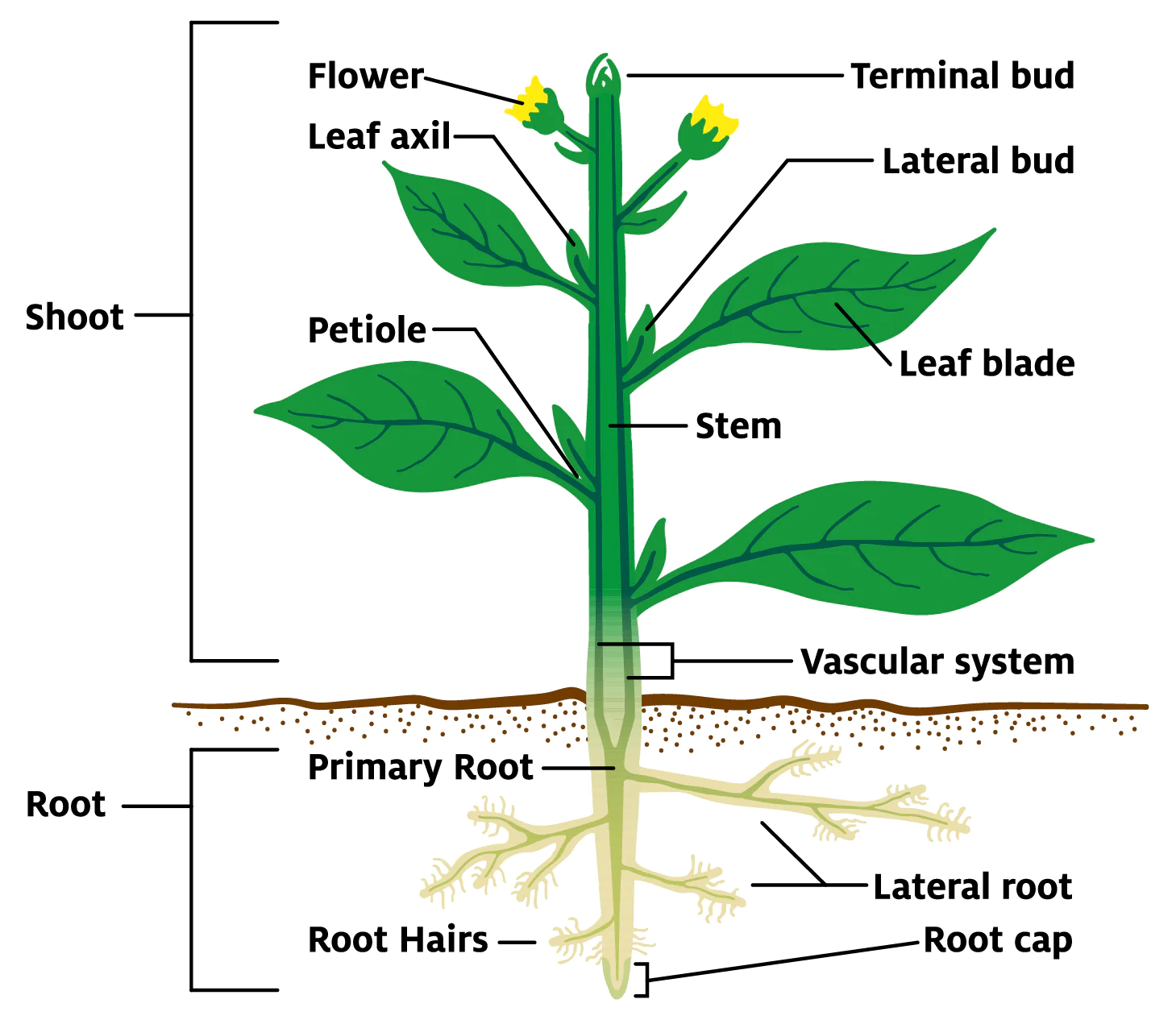Basic characteristics of plants
Plants have four major organs:
- Roots allow the plant to anchor itself and absorb water from the ground. This absorbed water is used by the plant for various processes, such as growing. Root hairs are hairs on the surface of the roots. They primarily increase the root's surface area and allow the plant to absorb more water in a small amount of time. Mycorrhizae are fungi that help plants. They absorb water and nutrients and give them to the plant, and in exchange, the plant gives the fungi some of the sugars it produces. This is a mutualistic relationship.
- Stems are above ground and primarily support the plant. They also transport water, minerals, and sugars from one part of the plant to another. If the stem is cut, a major part of the plant can die, so plants protect their stems with thorns and spines.
- Leaves are sites for photosynthesis. They contain pigments that absorb light. The palisades mesophyll are tightly packed cells that contain chloroplasts and primarily absorbs light. The palisades mesophyll is surrounded by spongy mesophyll, which are cells with some dispersed spaces. Leaves also have openings called stomata, which allow gas exchange in the plant (taking in CO2 and releasing O2). Unfortunately, leaves can also result in a loss of water through evaporation. This process is called transpiration, and the plant must determine its need for photosynthesis with the cost of losing water.
- Leaves also contain a cuticle, which is a wax covering. This reduces the transpiration rate.
- Guard cells surround the stomata and control whether the stomata is open or closed. In this way, they can control gas exchange and the transpiration rate.
- Sunken stomata are stomata that are in grooves below the surface of the leaf. They reduce transpiration because they are shielded from wind blowing over the surface of the leaf.
- Trichomes are plant hairs that can slow down air movement, increase solar reflection, and even secrete toxic substances that make the plant inedible and inhospitable.
Flowers are the plant's reproductive organs. Eggs and pollen are produced in the flowers. Pollination can occur by wind, insects, or even large animals like bats. It happens when pollen is transferred from one flower to another.

Gas exchange
During photosynthesis, plants absorb CO2 and release O2, generating ATP in the process. The transfer of gas into and out of the plant occurs through the plant's stomata and follows a number of steps:
- CO2 diffuses into the leaf. When the environment is very hot or dry, the guard cells surrounding the stomata close, preventing the plant from losing water due to transpiration.
- CO2 diffuses into the water inside the leaf. The CO2 passes through the spongy mesophyll tissue and enters the water inside the leaf. The CO2 in the water then diffuses into the cells in the leaf.
- CO2 enters photosynthesizing cells, so that the palisade mesophyll cells can perform photosynthesis.
- O2 diffuses into the roots of the plant from the soil. O2 moves from gas-filled pores in the soil to the roots of the plant. The oxygen gas is used by the plant to perform cellular respiration.
Stomata control
We already established that guard cells in the leaf of the plant control whether the stomata are open or closed. However, this process is much more complicated. There are a series of steps that cause the guard cells to open or close the stomata:
- An electrical gradient forms when the guard cells pump out H+ ions through ATPase proton pumps. This creates an electrical gradient across the cell membrane.
- An osmotic gradient is then established when potassium ions flow into the guard cells. The gradient of K+ ions creates a gradient that drives osmosis.
- Water then enters the guard cells, causing them to be come turgid and open the stomata.
- When the stomata need to close, water flows out of the guard cells.
